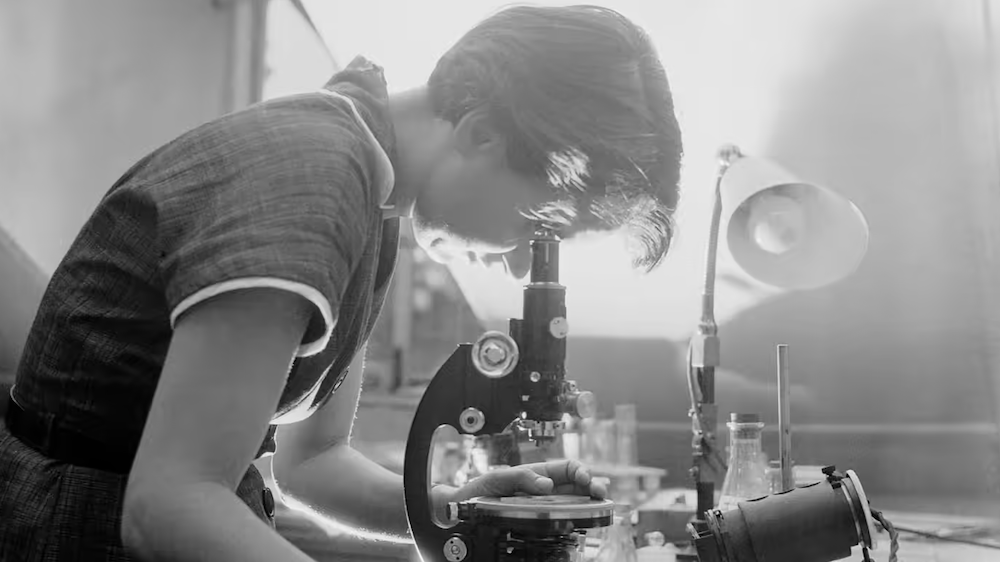
In 1962, scientists James Watson, Francis Crick and Maurice Wilkins received the Nobel Prize in Medicine for discovering the double helix structure of DNA. However, it has long been believed that the trio never would've made this significant discovery if they hadn't stolen data from Rosalind Franklin, a British chemist who was the first person to determine that DNA had a helical structure, similar to a spiral staircase.
Now, a previously overlooked letter and never-published news article, both penned in 1953, confirm that Franklin played as big a role in the discovery of DNA structure as the other Nobel winners, though she died before the prize was awarded, making her ineligible.
Still, she probably freely shared her knowledge with Watson and Crick, rather than having her X-ray images used without her knowledge, as Watson himself implied, according to a new paper published online on April 27 in the journal Nature.
"We wanted to set the record straight," Nathaniel Comfort, a professor of the history of medicine at Johns Hopkins University in Baltimore and co-author of the paper, told Live Science.
Working alongside Matthew Cobb, a professor of zoology at the University of Manchester in England, Comfort dug into the archives at the University of Cambridge's Churchill College and found an unpublished article for Time magazine by London journalist Joan Bruce, who wrote the draft in consultation with Franklin.
In the article, Bruce wrote that the group of scientists had divided themselves into teams, one consisting of Wilkins and Franklin, who focused on X-ray analysis of DNA, and the other of Watson and Crick, who were working to solve DNA's structure through a model-based approach. (In 1953, Watson and Crick published a paper in Nature on DNA's structure that was based on both X-rays and models.)
Related: Mysterious protein makes human DNA morph into different shapes
While they often worked independently, they also "linked up, confirming each other's work from time to time, or wrestling over a common problem," Bruce wrote. Given this dynamic, Franklin likely freely shared her knowledge of DNA's spiral structure with Watson and Crick, the Nature paper suggests.
The second piece of evidence was a letter written by Pauline Cowan, one of Franklin's colleagues. In the letter, Cowan invited Crick to a speech given by Franklin about how DNA can take on different forms.
"This was the biggest surprise for us since it showed that there wasn't this dramatic race like you see in modern competitive labs," Cobb said.
Cobb and Comfort concluded that Franklin was relaxed in knowing that Crick and Watson knew about her research, writing in their Nature paper that Franklin was "an equal contributor to solving [DNA's structure]."
So, what caused the true story behind the discovery of DNA to become so muddled?
That's all thanks to Photograph 51, an X-ray taken by Franklin in 1952 that depicted a strand of DNA from human tissue.
In his 1968 book "The Double Helix," Watson alleged that he saw Franklin's photograph without her knowing and upon first glance he was able to spot DNA's double-helix structure, making it appear that Franklin lacked the knowledge to decipher the image on her own, according to the paper.
In reality, "she knew it was a helix," Cobb said. For instance, in notes from a seminar she gave in 1951, she described both forms of DNA as a "big helix with several chains," according to the new study. (In solution, DNA can take on a crystalline "A" form or a paracrystalline "B" form.)
"[Our research] presents a better picture of Franklin," Comfort said. "Before, she was reduced from being a scientist to a tragic heroine and had no agency in the story. We wanted to reinstate her as a fully fleshed scientist."
Still, if her image led Watson to realize DNA was a double helix, then Watson and Crick committed a faux-pas when they didn't cite Franklin in their landmark paper. (It is standard scientific practice to include researchers whose work informs yours in the reference section of a paper.)
However, in a followup paper published in 1954, perhaps in an attempt to right their wrong, they did offer Franklin credit by stating that it would've been "impossible" to discover DNA's structure without her data, according to the Nature paper.







